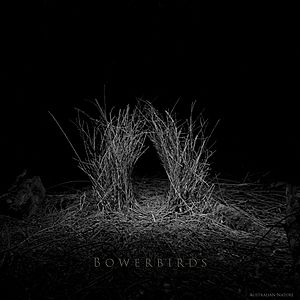Bowerbird facts for kids
Quick facts for kids Bowerbirds |
|
|---|---|
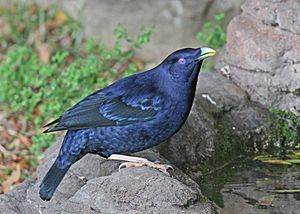 |
|
| Male satin bowerbird Ptilonorhynchus violaceus |
|
| Scientific classification |
|
| Kingdom: | Animalia |
| Phylum: | Chordata |
| Class: | Aves |
| Order: | Passeriformes |
| Parvorder: | Corvida |
| Superfamily: | Menuroidea |
| Family: | Ptilonorhynchidae G. R. Gray, 1841 |
| Type genus | |
| Ptilonorhynchus Kuhl, 1820
|
|
| Genera | |
|
Ailuroedus |
|
Bowerbirds make up the bird family Ptilonorhynchidae. They are renowned for their unique courtship behaviour, where males build a structure and decorate it with sticks and brightly coloured objects in an attempt to attract a mate.
The family has 19 species in eight genera. These are medium to large-sized passerines, ranging from the golden bowerbird at 22 cm (8.7 in) and 70 g (2.5 oz) to the great bowerbird at 40 cm (16 in) and 230 g (8.1 oz). Their diet consists mainly of fruit but may also include insects (especially for nestlings), flowers, nectar and leaves in some species. The satin and spotted bowerbirds are sometimes considered agricultural pests due to their habit of feeding on introduced fruit and vegetable crops and have occasionally been killed by affected orchardists.
The bowerbirds have an Austro-Papuan distribution, with ten species endemic to New Guinea, eight endemic to Australia, and two found in both. Although their distribution is centered on the tropical regions of New Guinea and northern Australia, some species extend into central, western, and southeastern Australia. They occupy a range of different habitats, including rainforest, eucalyptus and acacia forest, and shrublands.
Behavior and ecology
The Ailuroedus catbirds are monogamous, with males raising chicks with their partners, but all other bowerbirds are polygynous, with the female building the nest and raising the young alone. These latter species are commonly dimorphic, with the female being drabber in color. Female bowerbirds build a nest by laying soft materials, such as leaves, ferns, and vine tendrils, on top of a loose foundation of sticks.
All Papuan bowerbirds lay one egg, while Australian species lay one to three with laying intervals of two days. Bowerbird eggs are around twice the weight of those of most passerines of similar size – for instance eggs of the satin bowerbird weigh around 19 g (0.67 oz) as against a calculated 10 g (0.35 oz) for a passerine weighing 150 g (5.3 oz). Eggs hatch after 19 to 24 days, depending on the species and are a plain cream color for catbirds and the tooth-billed bowerbird, but in other species possess brownish wavy lines similar to eggs of Australo-Papuan babblers. In accordance with their lengthy incubation periods, bowerbirds that lay more than one egg have asynchronous hatching, but siblicide has never been observed.
Bowerbirds as a group have the longest life expectancy of any passerine family with significant banding studies. The two most studied species, the green catbird and satin bowerbird, have life expectancies of around eight to ten years and one satin bowerbird has been known to live for twenty-six years. For comparison, the common raven, the heaviest passerine species with significant banding records, has not been known to live longer than 21 years.
Courtship and mating
The most notable characteristic of bowerbirds is their extraordinarily complex courtship and mating behavior, where males build a bower to attract mates. There are two main types of bowers. Prionodura, Amblyornis, Scenopoeetes and Archiboldia bowerbirds build so-called maypole bowers, which are constructed by placing sticks around a sapling; in the former two species these bowers have a hut-like roof. Chlamydera, Sericulus and Ptilonorhynchus bowerbirds build an avenue type-bower made of two walls of vertically placed sticks. Ailuroedus catbirds are the only species which do not construct either bowers or display courts. In and around the bower, the male places a variety of brightly colored objects he has collected. These objects – usually different among each species – may include hundreds of shells, leaves, flowers, feathers, stones, berries, and even discarded plastic items, coins, nails, rifle shells, or pieces of glass. The males spend hours arranging this collection. Bowers within a species share a general form but do show significant variation, and the collection of objects reflects the biases of males of each species and its ability to procure items from the habitat, often stealing them from neighboring bowers. Several studies of different species have shown that colors of decorations males use on their bowers match the preferences of females.
In addition to the bower construction and ornamentation, male birds perform involved courtship displays to attract the female. Research suggests the male adjusts his performance based on success and female response.
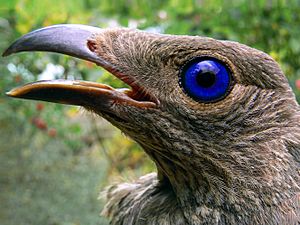
Mate-searching females commonly visit multiple bowers, often returning to preferred bowers several times, and watching males' elaborate courtship displays and inspecting the quality of the bower. Through this process the female reduces the set of potential mates. Many females end up selecting the same male. Females mated with top-mating males tend to return to the male the next year and search less.
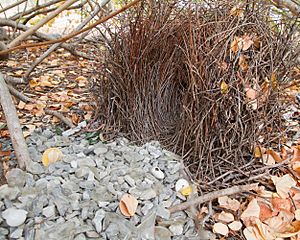
This complex mating behaviour, with its highly valued types and colors of decorations, has led some researchers to regard the bowerbirds as among the most behaviorally complex species of bird. Inspired by their seemingly extreme courtship rituals, Charles Darwin discussed both bowerbirds and birds-of-paradise in his writings.
In addition, many species of bowerbird are superb vocal mimics. MacGregor's bowerbird, for example, has been observed imitating pigs, waterfalls, and human chatter. Satin bowerbirds commonly mimic other local species as part of their courtship display.
Bowerbirds have also been observed creating optical illusions in their bowers to appeal to mates. They arrange objects in the bower's court area from smallest to largest, creating a forced perspective which holds the attention of the female for longer. Males with objects arranged in a way that have a strong optical illusion are likely to have higher mating success.
Taxonomy and systematics
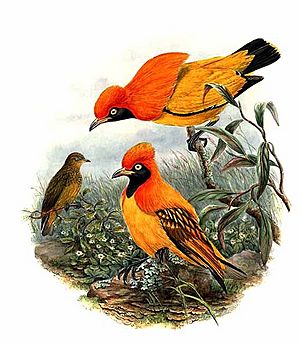
Though bowerbirds have traditionally been regarded as closely related to the birds of paradise, recent molecular studies suggest that while both families are part of the great corvid radiation that took place in or near Australia-New Guinea, the bowerbirds are more distant from the birds of paradise than was once thought. DNA–DNA hybridization studies placed them close to the lyrebirds; however, anatomical evidence appears to contradict this placement, and the true relationship remains unclear. Bowerbirds have a fossil record that extends to the late Oligocene, with the fossil species Sericuloides marynguyenae dated to 26 to 23 million years ago.
Genus Ailuroedus
- Ochre-breasted catbird, Ailuroedus stonii
- White-eared catbird, Ailuroedus buccoides
- Tan-capped catbird, Ailuroedus geislerorum
- Green catbird, Ailuroedus crassirostris
- Spotted catbird, Ailuroedus maculosus
- Huon catbird, Ailuroedus astigmaticus
- Black-capped catbird, Ailuroedus melanocephalus
- Northern catbird, Ailuroedus jobiensis
- Arfak catbird, Ailuroedus arfakianus
- Black-eared catbird, Ailuroedus melanotis
Genus Scenopoeetes
- Tooth-billed catbird, Scenopoeetes dentirostris
Genus Archboldia
- Archbold's bowerbird, Archboldia papuensis
- Sanford's bowerbird, Archboldia sanfordi (This species' validity is disputed; currently considered conspecific with Archboldia papuensis in most references.)
Genus Amblyornis
- Vogelkop bowerbird, Amblyornis inornata
- MacGregor's bowerbird, Amblyornis macgregoriae
- Huon bowerbird, Amblyornis germanus
- Streaked bowerbird, Amblyornis subalaris
- Golden-fronted bowerbird, Amblyornis flavifrons
Genus Prionodura
- Golden bowerbird, Prionodura newtoniana
Genus Sericulus
- Flame bowerbird, Sericulus ardens
- Masked bowerbird, Sericulus aureus
- Fire-maned bowerbird, Sericulus bakeri
- Regent bowerbird, Sericulus chrysocephalus
Genus Ptilonorhynchus
- Satin bowerbird, Ptilonorhynchus violaceus
Genus Chlamydera
- Western bowerbird, Chlamydera guttata
- Spotted bowerbird, Chlamydera maculata
- Great bowerbird, Chlamydera nuchalis
- Yellow-breasted bowerbird, Chlamydera lauterbachi
- Fawn-breasted bowerbird, Chlamydera cerviniventris
Note that the ptilonorhynchid catbirds, the grey catbird (Dumetella carolinensis) and black catbird (Melanoptila glabrirostris) from the Americas, and the Abyssinian catbird (Parophasma galinieri) from Africa, are only related by their common name; they belong to different families.
See also
 In Spanish: Pergoleros para niños
In Spanish: Pergoleros para niños


